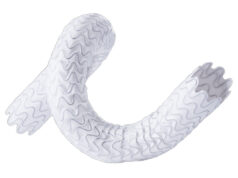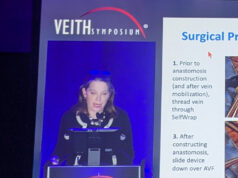
“Study design is critically important when interpreting outcomes,” said Bart Dolmatch (Mountain View Hospital, Mountain View, USA) in his evaluation of the “disconnect” between target lesion primary patency (TLPP) and access circuit primary patency (ACPP) analysing AVeNEW study data at this year’s Endo Vascular Access (EVA) meeting (14–15 June, Patras, Greece).
AVeNEW, a prospective and randomised study, compared outcomes using the Covera (BD) vascular covered stent versus percutaneous transluminal angioplasty (PTA) for the treatment of stenotic lesions in the venous outflow of upper-extremity arteriovenous fistulas (AVFs). Composed of 280 patients enrolled at 24 sites in the USA, Europe, Australia, and New Zealand, 142 patients were randomised to treatment with Covera and 138 patients to PTA.
Alongside criteria stipulating that enrolled patients have a 50% or greater target stenosis and evidence of dysfunction, Dolmatch noted that non-target stenoses were also allowed, but could only be treated with PTA. Primary outcomes were 30-day safety and six-month TLPP, powered to test whether TLPP after covered-stent placement was superior to PTA alone. Twelve-month TLPP and six-month ACPP were also evaluated while additional clinical outcomes were observed through to two years.
Dolmatch stated that their results showed comparable and non-inferior safety for the PTA group compared to the group treated with the covered stent, while the covered stent group had superior TLPP and fewer target-lesion reinterventions through to 24 months. In terms of efficacy, he added that they saw a “very significant” improvement of TLPP for the covered stent group, which was 30% more than TLPP for the PTA group at six months. “However, that’s the target lesion,” he said, stating that when they looked at circuit patency, it appeared to be numerically better for patients who received the covered stent, but not statistically superior.
“So you have to wonder, why was TLPP superior, yet ACPP was not statistically better for the covered stent group?” Answering this question, Dolmatch suggested that the answer is largely related to the study protocol which allowed enrolment of patients with non-target stenoses that were found in roughly one third of all patients enrolled in the AVeNEW trial. Per protocol, non-target stenoses could only be treated with angioplasty. While this reduced primary circuit patency for both groups, there were randomly more non-target stenoses in the covered stent group. Frequent and early recurrence of non-target stenoses after PTA led to a disproportionally greater loss of circuit patency in the Covera group, even though the target treatment site had better patency with the covered stent.
“By allowing enrolment of patients with non-target stenoses treated only with angioplasty, ACPP was reduced in both groups,” Dolmatch concluded. In the Covera group, more patients were had non-target stenoses treated with PTA, which had a greater impact on ACPP when compared ACPP for the angioplasty group. He added that, although circuit patency was numerically greater for the Covera group, it did not reach statistical significance due to the “random and disproportionately higher number of non-target stenoses in the covered stent group”.
He offered pros and cons for including patients with secondary stenoses in this type of randomized, prospective clinical trial. By including patients with non-target stenoses the AVeNEW study was closer to a “real-world” experience since many dysfunctional AVFs will often have more than one stenosis. Furthermore, faster enrolment was possible by including patients with non-target stenoses. But the downside was that primary circuit patency was more quickly lost due to non-target stenosis even though the target lesion had superior outcome with the covered stent.
Exploring how this study could have been designed to better address the impact of target lesion treatment upon circuit patency, Dolmatch first suggested simply not including patients with non-target stenoses. Alternatively—and perhaps more realistically—he recommended treating both target and non-target stenoses with the mode the patient was randomised to, PTA or covered stent.
Dolmatch reiterated the importance of study design when interpreting outcomes, and believes that the markedly improved TLPP with the covered stent reiterates the benefit using covered stents in AV access circuits. He concluded by stating that more data is on the way, with results from the post-approval AVeNEW study of 100 consecutive patients treated with the Covera covered stent to be presented at this year’s Cardiovascular and Interventional Radiological Society of Europe (CIRSE) annual congress (14–18 September, Lisbon, Portugal).











